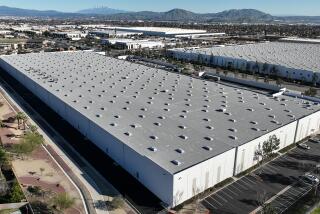Furniture Firms Get Reprieve on Schedule of New Pollution Rules
The staff of the South Coast Air Quality Management District has backed off a controversial schedule to impose stringent air pollution controls on the Southland’s furniture industry, it was announced Friday.
As a result, the AQMD board postponed until Aug. 5 its public hearings, originally scheduled for Friday, on how and whether to implement a revised plan that would give the furniture makers eight years to comply instead of two to six years. An industry spokeswoman cheered the move but said it did not go far enough.
The local industry generates annual sales of $1.3 billion and employs 63,000 Southern Californians. But their use of paint, varnish and other coatings produces about 2% of the 1,246 tons of controversial, smog-causing hydrocarbons that pour into the area’s air each day.
The amended plan drafted and presented by AQMD staff to the board Friday calls for all of the area’s furniture makers to adopt progressively less polluting paint, varnish and other coatings over the next eight years. The staff previously sought to oblige large users of wood finishes to reduce hydrocarbon emissions within two years and small users to cut back within six years. The original plan also would have pushed the use of costly air cleaning devices.
The revision will make industry compliance easier without making Los Angeles air dirtier in the long run, AQMD spokesman William J. Kelly said. “We’re still calling for an 80% reduction” in hydrocarbon emissions, he said.
Six Times Annual Profit
Furniture manufacturers had complained vociferously that the original AQMD proposal would drive them out of business--or at least out of the area. “It would definitely put us out of business in Southern California,” said Steven L. Cohodes, chief financial officer of Compton-based Executive Office Concepts.
Attaching air cleaning devices to the spraying booths in which coatings are applied to furniture would have meant for Executive Office Concepts an initial investment of $800,000 to $1 million plus annual maintenance and operating costs of $100,000, he said. Including the cost of borrowing money, Cohodes said, compliance would have cost six times the company’s annual profit for each of the next seven or more years.
Although somewhat mollified, the furniture industry still has objections to the new plan, said Sharon F. Rubalcava, outside attorney for the California Furniture Manufacturers Assn. Less polluting, water-based coatings are not yet available for commercial use and may not be developed in time to meet the AQMD’s schedule, she said.
AQMD board member Sabrina Schiller charged at Friday’s meeting that such coatings are available and that the industry is dragging its feet. Upon her appointment in 1983, she said, “I personally visited a (wood-finishing) factory in the San Fernando Valley that had been using waterborne coatings for five years.”
But Cohodes said these coatings are not in general commercial use because they do not wear as well, last as long or shine as brightly as traditional coatings. “I’ve got furniture in my office that is six or seven years old that with regular polishing looks as new as the day they walked off the (production) line,” he said.
Auto Paint Shops Affected
With the new coatings, he continued, the same desk and cabinets could lose their shine in two to four years.
Water-based coatings also do not look as attractive on new furniture, Cohodes said, and that would make it tough to compete with furniture makers based outside Southern California. “If you set the furniture side by side, with the proposed water-soluble, low-(hydrocarbon) finishes, our appearance is not going to match.”
In a related matter, the AQMD board voted 6-1 Friday to require 4,000 auto paint shops in the Los Angeles area to eliminate most of their hydrocarbon emissions beginning in 1990.
Hydrocarbons are a key ingredient of photochemical smog. According to the AQMD, paints and solvents are by far the biggest contributors to hydrocarbons emissions from stationary sources. Of the 590 tons spewed daily into the atmosphere, paints and solvents account for 382 tons.
Automobile spray paint shops alone account for 38.5 tons of hydrocarbons a day, compared to 15.6 tons per day from all the oil refineries in the South Coast Air Basin. The new rule would limit those total emissions from auto paint shops to 5.5 tons daily by July 1, 1991.
More to Read
Inside the business of entertainment
The Wide Shot brings you news, analysis and insights on everything from streaming wars to production — and what it all means for the future.
You may occasionally receive promotional content from the Los Angeles Times.










